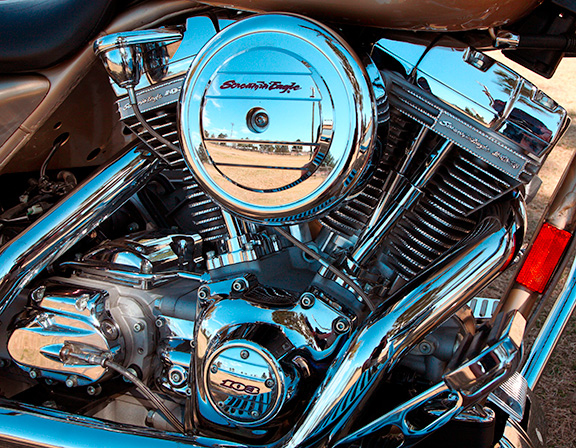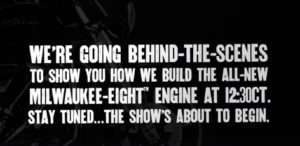Rumor has it that a new Harley V-Twin engine, 107 MILWAUKEE-EIGHT, is just around the corner

The Twin Cam engine is 18 years old.
Rumors of a new Harley-Davidson V-twin engine are nothing new. I usually pay little attention to them because most of the banter is pure speculation or wishful thinking. However, a new rumor about a 107 ci 4-valve engine surfaced a few months ago, including close-up engine photos that have had a habit of appearing, disappearing and then reappearing again. Two photos are posted on Head Quarters’ Facebook site.
https://www.facebook.com/pages/Head-Quarters/105661307966
The new engine is rumored to have 4-valve heads (a total of eight valves), 107 cubic inch displacement, and is named the “107 MILWAUKEE-EIGHT.” “EIGHT” referring to eight valves, and, of course, Milwaukee is home to Harley-Davidson. The air cleaner in one of the photos includes the “107 MILWAUKEE-EIGHT” branding.
Interestingly, in late June 2014, Harley-Davidson filed to trademark the name “MILWAUKEE-EIGHT.” Since I’m not one who believes in coincidences, I’d surmise a new Big Twin engine or at least a significant update is coming sooner rather than later. After all, it’s been about 18 years since the Twin Cam engine was first introduced; the Evolution Big Twin had a lifespan of roughly 15 years, while the Shovelhead was available for about 20 years. As such, a major design upgrade to the Twin Cam engine shouldn’t surprise anyone.
Surely, the “107” on the air cleaner represents 107 cubic inch displacement. That could be easily achieved using the current 4.375” stroke crankshaft and increasing the current 103 ci engine bore by 1/16-inch from 3.875-inch to 3.938-inch. Hopefully, the new cylinders will be beefier and not just bored thinner. If just bored thinner, they’ll become expensive throwaways without any oversize pistons available. Moreover, I wonder if the traditional iron liner will be retained, what size big-bore cylinders will be available, and whether the new engine will fit into current Twin Cam frames.
Four-valve heads are not new to Harley-Davidson engines. Jim Feuling adapted 4-valve heads to the Harley Big Twin Evolution engine, using two adjusting screws on each forked rocker arm for valve adjustment. In theory, smaller, lighter valves can be revved higher before encountering valve float than heaver valves. Since rpm times torque divided by 5252 equals horsepower, higher rpm “can” lead to improved performance, considering the rest of the engine can handle any additional stresses. And two smaller valves “should” flow more than one larger valve for a given combustion chamber size, so that too “may” lead to improved performance. But four-valve heads generally perform better at higher rpm (and with overhead cams), yet the Twin Cam is not a high revving engine.
Nevertheless, I suspect the factory chose a 4-valve head design primarily for other reasons, at least in part, possibly for reduced heat, especially around the exhaust ports. Shorter ports along with faster, more efficient combustion would go toward reducing heat.
That said, a few other questions come to mind. For instance, is the new engine overhead cam or pushrod actuated; does it have one, two or three camshafts; and is it air, water or oil cooled? We can see in one photo what appears to be a pushrod tube on the rear cylinder. That would indicate the engine is not overhead cammed, instead being pushrod actuated.
Regarding the number of camshafts, I’ve heard rumors about the new engine having three camshafts and even multiple oil pumps. Neither photo shows the cam gearcase area or whether the pushrods are parallel (like the Harley Sportster or Indian Thunder Stroke engine).
If the pushrods are parallel, I would lean toward a 3-cam design (one intake and two exhaust cams), possibly similar to the Indian Thunder Stroke or S&S X-Wedge. But remember, three camshafts would change the aesthetics of the engine’s right side gearcase and pushrod alignment, which probably would not be desirable in keeping with Harley’s Big Twin tradition.
If the pushrods are angled, similar to the current Twin Cam engine, two cams would be more in order. But here’s a thought: would the factory dare go back to a single-cam design to eliminate the complexity, high costs, parts count, and other issues associated with the current dual-cam setup? I guess the answer depends on what the factory’s design objectives are: less complexity, improved reliability, reduced maintenance, lower costs, marketing priorities, the list goes on.
High heat has been an issue with the Twin Cam engine. That leads to the question of whether the new engine will be air or water cooled, or a combination of air cooling supplemented by oil in the cylinder head area. The answer to cooling may depend on which model bike or bikes the new engine is mated with.
Large touring models and Trikes have lots of canvas area to mount and hide water-cooling radiators. But wouldn’t it be nice if bulky radiators could be eliminated with oil-cooled heads. On smaller Softail models using the “B” motor, supplemental oil-cooled heads surely would be in order. And multiple oil pumps or multi-staged pumps may come into play here. Multiple pumps may also be used for improved crankcase and gearcase oil scavenging. If the new engine is fitted to Softail models, Harley engineers may also want to improve upon the “B” motor’s internal chain-driven balance shaft system, as well.
Clearly, we have generated more questions than answers about a rumored 107 MILWAUKEE-EIGHT engine. Without a better view of the engine and clear insight about the factory’s design objectives, its difficult to say what the exact engine specs will be. Worldwide, Harley sales have been relatively soft, so a new engine could give Harley a marketing boost. Emission requirements and high engine heat may also be driving Harley’s design specs.
And if we assume a typical High Output 103 ci Twin Cam engine makes roughly 76-77 rear wheel horsepower in stock trim, that’s only .75 horsepower per cubic inch, which is not very stout. At the very least, two smaller valves should boost intake velocity. When combined with shorter valve timing, a fast-burn combustion chamber, and possibly a compression ratio increase, the new engine should have increased torque with a wider, flatter torque curve. And quicker combustion results in less heating of the cylinder head area. Surely, any performance bump the 4-valve heads may provide would be welcome by both the factory and Harley owners.
I haven’t heard of any clamor from Harley owners for a 4-valve head, but if it fixes the excessive-heat problem and gives a performance boost, I’d take it. On the other hand, I’ve heard of many Twin Cam riders wanting a stiffer crank, wiggle-free left-side main bearing, lower maintenance and trouble-free cam chest, and a primary chain adjuster that doesn’t lock up. None of these problems plagued the earlier generation single-cam Evo Big Twin engine, so proven fixes are known. Surprise, maybe a single-cam engine is the answer. I’d call that “going back to the future.”
The annual Harley-Davidson Dealer Meeting is scheduled for August 23-25 in Boston, MA. New 2017 models will be introduced then. And deliberate or accidental information leaks about the new engine may happen before then, especially with Sturgis coming up, so it will be an interesting month pondering what a new 107 ci MILWAUKEE-EIGHT engine may bring to HOG riders worldwide. Maybe a “back to the future” engine is the perfect ticket. (TVR)

